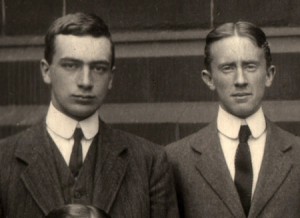
Garth introduces the feature as follows: A salutary lesson in his youth taught Tolkien that fairy-stories are not only or mainly for children. Here I uncover the who, the where and the when.
Tolkien and the boy who didn’t believe in fairies
The manuscripts of Tolkien’s deeply influential lecture ‘On Fairy-stories’ include a striking anecdote in which that great proponent of Faërie, the author, recalls being put in his place by a small, thoroughly scientifically-minded boy. It is an entertaining little nugget, but I would suggest that it is more than that: it identifies a moment in the author’s life which encapsulated for him, even some thirty years later, the defining idea behind his legendarium: that fairy-stories are not solely or primarily for children. Here I not only reveal the identity of the boy, but also provide photographs of both child and garden, while offering some thoughts on the date of the incident.
The anecdote appears among the pages written by J.R.R. Tolkien when he was revising and enlarging his original 1939 Andrew Lang lecture for publication in Essays Presented to Charles Williams, published in 1947. However, the passage itself was excised by the author and leaves no direct trace in ‘On Fairy-stories’. It finally appeared in 2008 in Tolkien On Fairy-stories, edited by Verlyn Flieger and Douglas A. Anderson, which includes Tolkien’s fascinating an extensive drafts of the lecture.
Tolkien introduces the incident to illustrate why the fairy-story should not be specially tailored for children in either tone or content. ‘Do not let us write only for them, certainly not “down” to them,’ he warns: children old enough to enjoy a fairy-story are already old enough to know when they are being patronised. ‘Children prefer adult conversation – when it is not infantile in all but idiom. But being talked down to (even in verbal idiom) is a flavour that they perceive quicker than any “grown-up”…’
Tolkien describes the encounter as a ‘salutary lesson’:
I was walking in a garden with a small child. I was only nineteen or twenty myself. By some aberration of shyness, groping for a topic like a man in heavy boots in a strange drawing room, as we passed a tall poppy half-opened, I said like a fool: ‘Who lives in that flower?’ Sheer insincerity on my part. ‘No one,’ replied the child. ‘There are Stamens and a Pistil in there.’ He would have liked to tell me more about it, but my obvious and quite unnecessary surprise had shown too plainly that I was stupid so he did not bother and walked away.
Tolkien gives no hints regarding the location of the garden, and few about the identity of the young sceptic. Indeed there is little here, beyond faith in Tolkien’s veracity, to indicate that the incident is more than a concoction to enliven his essay. However, he does recollect the boy’s age – ‘five was young for such good sense’ – and adds: ‘The child certainly later became a botanist.’
BOOTNOTE: John has dedicated this article to his cousin’s four-year-old boy Charlie (who is also the grandson of the man who introduced him to the works of Tolkien).
Charlie has cerebral palsy. Thanks to the amazing fundraising efforts of his parents, he has just had spinal surgery which could change his life. He has a chance to win £5,000 to pay for 100 hours of vital physiotherapy. It all depends on votes, and I hope you will take a moment to help him with yours. There are no obligations attached. To vote, please click here.
UPDATE: John writes: You’ll be delighted to hear that Charlie, my cousin’s little boy with cerebral palsy, has won the £5,000 charity vote attached to my “Tolkien and the boy who didn’t believe in fairies” article. I’d like to thank you and readers of TheOneRing.net for your support with this –- in memory of Charlie’s grandfather, the man who introduced me to Tolkien and The Lord of the Rings. It was a race to the finish line and every vote counted. It means Charlie will get funding for 100 hours of physiotherapy to help him make the most of the dorsal rhizotomy operation he’s just had. He’s a fighter, and it seems this may put him on his feet at last.
The webpage will still be dedicated to Charlie, who is going to need muscle-strengthening equipment and eventually an electric wheelchair, among other things for which his parents will have to raise the funds. I will maintain a link for donations via the registered UK charity Tree of Hope.


